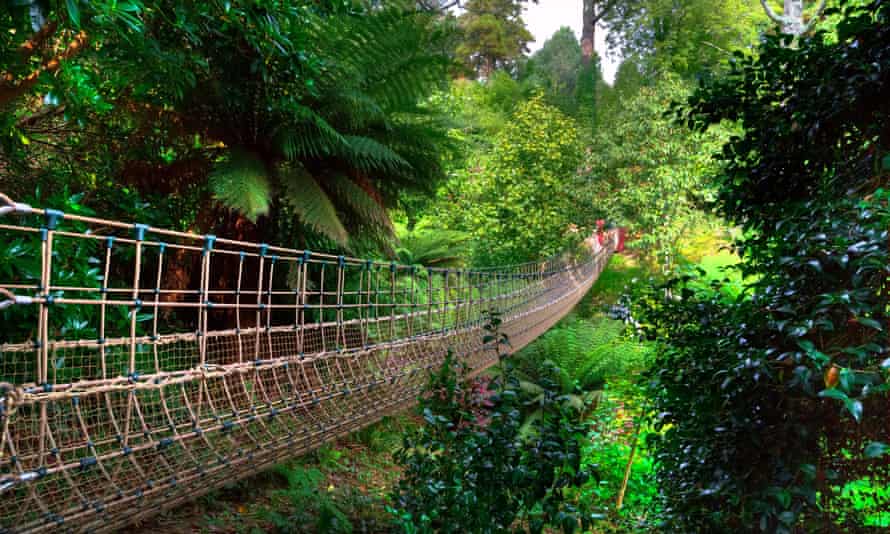According to its co-creator, Sir Roy Colin Strong: “A garden is an ever-evolving creation – like a painting that is never finished.” Strong and his wife, Julia Trevelyan Oman, started work on what was a bare, four-acre field in the mid-70s. At the time, they were both immersed in the art world: Strong as director of the National Portrait Gallery and, later, the Victoria and Albert Museum; Oman as a production designer for film, theatre, ballet and opera. Their life-long appreciation for art and staging is evident throughout this scintillating, autobiographical garden. There are more than 20 separate areas for visitors to explore including a pleached lime walk, a nymphaeum, a boxed parterre and a crinkle crankle parade dedicated to their cat.

The Duchess of Northumberland hit the headlines in 2004 when the Home Office granted her permission to grow drugs in Alnwick Garden. Now, as well as a hi-tech water cascade, a huge treehouse and the world’s largest Taihaku cherry orchard, visitors can book a guided tour of The Poison Garden, where magic mushrooms, cannabis, opium poppies and the coca plant are among the 100 or so toxic, intoxicating and narcotic plants that flourish behind bars.
This recently restored Regency pleasure garden was created on the site of a flat clay brickfield in the 1820s in the “Swiss picturesque” style. It’s the only complete example of a Regency landscape in the UK. There are 13 features to discover as you explore the serpentine paths including a thatched Swiss-style cottage, a Pulhamite-lined grotto and fernery (Pulhamite being a mix of rubble and cement modelled to simulate the texture and colour of natural stone) and an intricately detailed Indian kiosk with a secret, subterranean room. Beyond these carefully contrived nine acres you’ll find a lakeside walk and a hidden sculpture trail in the woods. There are events and craft activities for kids during the school holidays.
Charles Jencks, the cultural theorist, architectural historian, landscape designer and writer, was a renowned promoter of postmodernism. On just one day each year, visitors are admitted to explore his astonishing masterpiece, The Garden of Cosmic Speculation. Begun in 1989 in the grounds of the home he shared with his wife, Maggie Keswick, it’s divided into 40 areas and covers 30 acres. According to Jencks, who died in 2019, the garden “uses nature to celebrate nature, both intellectually and through the senses”. There are visual references to black holes, dark matter and fractal geometry. Other-worldly landforms rise and ripple out of mysterious pools of water, whilst scientific sculptures appear like immersive optical illusions.
Date and ticket information for 2022 TBC
This ancient sanctuary is a designated World Peace Garden that centres around the Chalice Well – a water source that has flowed ceaselessly for more than 2,000 years. The surrounding land was purchased by the spiritualist, Wellesley Tudor Pole, and preserved to “encourage individual spiritual evolution … to members of the public, of whatever religious persuasion or none, for pilgrimage, quiet contemplation and healing”. The flowing waters that spring from the well have been directed through the “numinous” space, channelled into waterfalls, curving rills and cleansing pools before disappearing underground and coursing towards Glastonbury Abbey.

This unfettered oasis – the second largest conservatory in London – provides a verdant, creative space for gallery goers and residents alike. It was built in the early 80s to conceal the concrete stump of the Brutalist fly tower used by the theatre below. (Original, unrealised plans show a giant glass pyramid floating on the lake.) Inside, tree ferns, date palms, coffee and ginger plants form a literal concrete jungle. There’s even an arid house for cacti, succulents and orchids. Koi carp and terrapins moved from Hampstead Heath idle in the shadowy ponds.
This mysterious underground garden was buried in rubble after the second world war and rediscovered in 2000. It was initially conceived by “Squire Oakley”, director of the Great Western Railway and fern enthusiast. He created a garden “the likes of which was not known to exist anywhere else” in the late 1800s. Above ground, rock gardens, glass houses, and a panoply of plants, shrubs and trees from around the world delighted visitors. Oakley’s enthusiasm for landscaping continued underground, where he created a subterranean labyrinth of tunnels, grottoes and ferneries, all of which have been fully restored.
Less a garden, more a site-specific artwork, Little Sparta lies across seven acres of open moorland of the Pentland Hills. Ian Hamilton Finlay began work here in the late 1960s, enlisting the help of local stone carvers, artists and poets to realise his vision. There are more than 270 artworks to discover. An interactive map on the website gives visitors an idea of the scope and variety of work, which ranges from carved tablets scattered across an undulating lawn, to the huge gilded head of Marsyas, a musical character from Greek mythology who appears half-buried underground. As stimulating as it is contemplative.

Plans for The World Garden came about in traumatic circumstances. The horticulturist, Tom Hart Dyke, was on a plant-hunting expedition in the Panamanian jungle when he was kidnapped and held hostage for nine months. During that time, he sketched plans for the garden. After his release in 2000, he began creating a garden of rare and important botanical plants in the grounds of Lullingstone Castle – one of England’s oldest family estates, of which he is the heir.
Plant enthusiasts will be able to explore the world in The Cloud Garden, The Cactus House, The Orchid Room and the Moroccan Blue Room (inspired by his visits to the Majorelle Gardens in Marrakech). Rarities include an example of the oldest tree in the world, the Australian dinosaur tree, and the world’s most dangerous plant, the Queensland stinger.

An enchanting garden with curious beginnings. Acres of formal gardens flourished at Heligan until the end of the 19th century, when bramble and bracken gradually began to reclaim the site. At the outbreak of the first world war, lives were diverted from the estate and it fell into decades of neglect until 30 years ago, when the gardens were “rediscovered”. In that time, Heligan has been fully restored and now offers the public a second chance to explore a landscape laid out more than two centuries ago. Highlights include the UK’s only outdoor, subtropical jungle planted with bamboo tunnels, tree ferns, giant rhubarb and bananas and a fragrant peach house.








